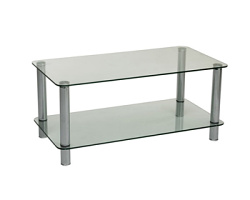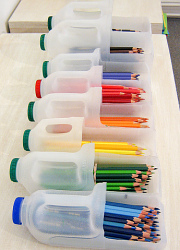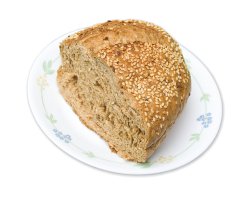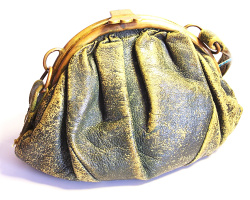 We’ve had an email from Josie:
We’ve had an email from Josie:
My council (Suffolk) say they’ll only recycle glass bottles not other glass like windows. I’ve got an old glass coffee table to get rid of, what can I do with it?
That’s a pretty standard glass recycling policy – only bottles and jars, not plate glass (like windows or photo frames) or cooking glass items (pyrex or other dishes) – so it’s probably better to look for reuse rather than recycling ideas.
Firstly, as with all furniture, try to pass it on to someone else who might still use it — even if you think it’s rather old fashioned or outdated, someone might appreciate having any table at all or love having it if they’re going for a retro thing ;) If it’s a nice piece that’s damaged, someone else might be willing to repair it. Offer it on Freecycle/Freegle, or to a furniture-accepting charity shop (not all charity shops have the space to accept furniture but some specialise in it).
If it’s not suitable for passing along, the glass might be reusable (either by yourself or someone else via Freecycle/Freegle) for a project around the home or garden – on top of another table/desk as a surface protector, to make a cold frame/as part of a greenhouse (although be careful about cutting out too much light if it’s smoked or frosted) or maybe mounted on the wall as a dry erase board?
Any other ideas?
Categories: household, items
Posted by louisa
on 1 September 2010
With their semi-rigid sides & strong handle, plastic milk bottles are very easily reusable – which is useful since there are bajillions generated every day.
We’ve had loads of great suggestions about them over the years but here are some of my favourites:
 1. Pencil sorter
1. Pencil sorter
Mentioned as a featured link a few weeks ago, I love how neat and practical these containers are for coloured pencils/pens. Stored on a shelf, the lids could be painted the colour of the pencils to make for easy identification.
2. Paint caddy
One close to my heart at the moment because we’re decorating – plastic milk jugs make great paint caddies. 4 pint/half-gallon/2ltr bottles are best for this – cut out the panel of plastic opposite the handle, leave the neck intact for strength and cut down to about half way. The handle is easy to hold (or you could loop some wire/string around it to hang it from a ladder rung) and the caddy holds about 2 pints/1ltr of paint at a time – enough to do a fair amount of painting.
3. Foraging container
SandyM’s family use gallon milk bottles as foraging containers – widen the neck and add a loop of rope or a strong belt through the handle holds it up, leaving both hands free for collecting fruit. In the UK, our bottles tend to be long & thin, so possibly the wrong shape for this – but a great idea if you can get hold of those bigger square bottles.
 4. Bird feeder
4. Bird feeder
One of the original ideas for reusing them – make them into bird feeders. The how-to uses gallon jugs but the same theory can be applied to smaller ones too – I’ve made mini ones for our mini-tree from 1ltr/2pint bottles.
(I’ve also used a plastic milk bottle as a grit hopper for our chickens – same principle as the bird feeder but with stones/shells instead of food. It would be a cruel joke if they didn’t need the grit for digestion.)
5. Scoops
Cut away a wedge from the bottom to make it into a scoop – for scooping flour/grain/animal feed or other dry goods, or at the other end, as a pet poop scoop. Leave the lid on to avoid spills from the other end.
What are your favourite reuses for plastic milk bottles?
Categories: household, items, kitchen, packaging
Posted by louisa
on 31 August 2010
 We’ve had an email from Milly:
We’ve had an email from Milly:
I know about making breadcrumbs with stale bread but is there anything that can be done with bread that’s gone a bit mouldy? I don’t mean eat it of course but compost it?
Obviously the best thing to do is avoid it going mouldy in the first place – freeze it if you don’t have time to use it up or turn it into breadcrumbs there and then. But sometimes loaves have a tendency to turn in a blink of an eye so it’s harder to avoid.
Bread is one of those things that some people compost and others don’t. It will break down quite quickly but in an open, slow going compost heap, it might attract vermin to the pile even quicker. It’s also not going to add that much goodness to the heap either so you might decide it’s not worth the risk. But then what do you do with it instead?
Any suggestions? Do you compost bread?
(Photo of non-moldy bread because looking for a photo of moldy bread was making me too queasy!)
Categories: food, items
Posted by louisa
on 27 August 2010
Over on my new frugal living/growing/cooking blog The Really Good Life today, I’ve asked a Reduce This related question: How can you tell when something is good quality?
The first stage of the recycling triangle is Reduce – reduce the amount of things you buy/use and buy items that’ll last and can be repaired rather than ones that need replacing frequently — but how can you tell what will last?
What cues tell you when something is worth the extra money? And when it definitely isn’t?
Do you have a particular area of expertise? If so, tell us all about it on The Really Good Life!
Categories: links, reduce this
Posted by louisa
on 26 August 2010
 We’ve had an email from Joanne:
We’ve had an email from Joanne:
Hi, I have an old leather zipped wallet type purse which is old, worn and quite grubby. I would rather recycle it somehow than put it in the bin but am not sure how to do this. Do you have any ideas?
First, it obviously depends on the state of the item but it might benefit from a makeover. Trying cleaning and polishing the leather, or if it’s suede (as Joanne suggested in her email’s subject line), you can get suede cleaning tools for just a couple of £/$s — they’re obviously good for maintaining all sorts of suede items, they don’t make them spotless but they can improve them a lot. Any other ideas for makeover/upcycling suggestions?
If it’s too far gone for that, the leather might be reclaimable for craft projects – including ones that’ll benefit from a “distressed” look to the leather. The suggestions given on our post about recycling leather/suede from an old sofa might need more leather than a small purse would provide but there still might be enough to make small things with — a larger handbag might have enough good quality leather to make a smaller coin purse. Or it could be used to make small art artefacts – like these cool leather scrap mushrooms.
Any other suggestions?
(I’ve used a stock photo, not Joanne’s actual purse so don’t feel restricted based on the photo – just think old leather purses/bags in general.)
Categories: clothes and fabric, household, items
Posted by louisa
on 25 August 2010
 We’ve had an email from Josie:
We’ve had an email from Josie:


 1. Pencil sorter
1. Pencil sorter 4. Bird feeder
4. Bird feeder We’ve had an email from Milly:
We’ve had an email from Milly: We’ve had an email from Joanne:
We’ve had an email from Joanne:














